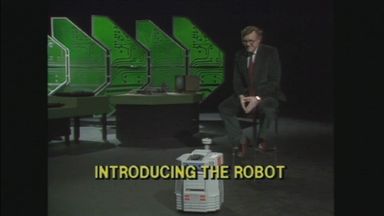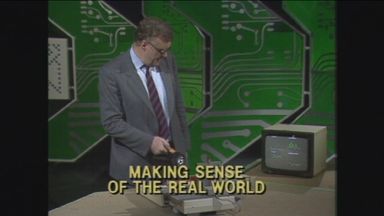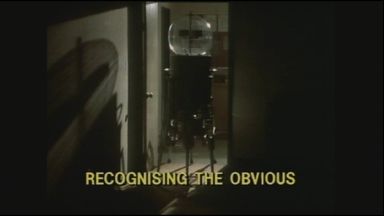Computers in Control
5. Recognising the Obvious
Clips from this programme
A prototype spider-like robot from Odetics aimed at working in hazardous conditions can lift a car and move around. It looks clever but it is in fact controlled by a human operator. Machine intelligence has far to go in recognising what we see as obvious.
Duration: 03:25A Westinghouse factory forging steam turbine blades, using a range of robots working cooperatively and using a vision system to check and make identical blade shapes.
Duration: 02:14A flexible manufacturing system (FMS) production line for machined parts in a UK factory recognises parts, sometimes using a vision system and allows for batch production
Duration: 05:18How a vision recognition system works - recognising features and pattern matching to compute what humans do so easily. Analysing an image using rules to isolate an image from background 'noise'.
Duration: 05:02Using a RAM chip as a crude camera to identify shapes using simple rules
Duration: 01:45Mac uses a speaker dependent voice recognition which has learned his voice and leaves messages for his stockbroker
Duration: 01:23Ian Trackman shows how a simple voice recognition system works using a system which can learn and then match word patterns.
Duration: 02:42Joe Engelberger, father of American Robotics explains how we will need to move to massive parallel processing to be able to recognise the things which humans find so simple.
Duration: 00:58Binky the studio ventriloquist dummy recognises some words and moves accordingly to end the series.
Duration: 00:33Computers in Control
1. Introducing the Robot
First broadcast: 2nd March 1984
Duration 24:42
An introduction to the world of robotics. 1: Introducing the Robot: A visit to the Chicago Robotics Exhibition shows how the computer has revolutionised these mechanical servants and even made domestic versions possible. IAN MCNAUGHT-DAVIS begins to look at how computers can sense what's going on round them and then control mechanical devices. Production DAVID ALLEN and ROBIN MUDGE
2. Making Sense of the Real World
First broadcast: 9th March 1984
Duration 24:45
An introduction to the world of robotics. Making Sense of the Real World. How can the computer detect such widely different things as the whereabouts of a London Transport bus, fog, the length of an electronic flash or the speed of a motor? IAN MCNAUGHT -DAVIS and JOHN COLL look at a wide range of sensors which are available on the market. Production DAVID ALLEN and ROBIN MUDGE
3. Making Things Move
First broadcast: 16th March 1984
Duration 24:36
An introduction to the world of robotics. 3: Making Things Move: IAN MCNAUGHT-DAVIS continues his exploration of the principles behind the use of the computer in robotics by finding out how to make things move - even using a home micro. Production DAVID ALLEN and ROBIN MUDGE
4. Getting it Together
First broadcast: 23rd March 1984
Duration 24:23
An introduction to the world of robotics. 4: Getting it Together: IAN MCNAUGHT-DAVIS looks at some of the thinking behind more complex computer-controlled devices. Production DAVID ALLEN and ROBIN MUDGE
5. Recognising the Obvious
First broadcast: 30th March 1984
Duration 24:36
An introduction to the world of robotics 5: Recognising the Obvious : We see, hear and interpret the real world with ease. For the computer it's not so easy, but some robotic systems can identify objects or voices and act accordingly, and it's possible to mimic these on the home microcomputer. Production DAVID ALLEN and ROBIN MUDGE
Now playing















